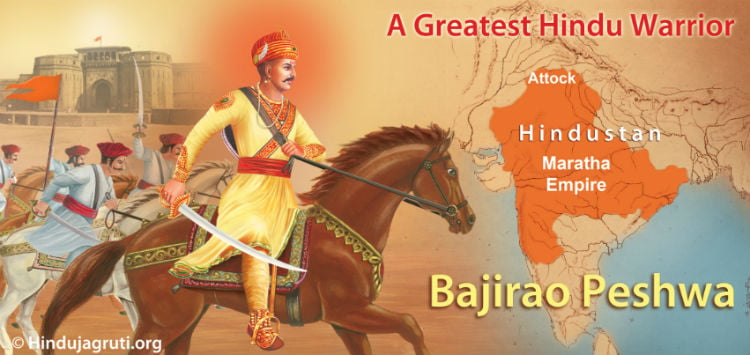 |
Content
1. Remembering Bajirao Peshwa – I
2. Shrimant Bajirao Peshwa (August 18, 1700 – April 28, 1740)
3. Birth and Early Life of Bajirao
4. Bajirao becomes The Peshwa (Prime Minister)
5. Expansion of Hindu Kingdom under the Supremacy of Peshwa Bajirao
6. Legacy
7. Quotes on Bajirao Peshwa
A) J. Grant Duff says in “History of the Marathas”
B) Sir R Temple says in “Oriental Experiences”
C) Jadunath Sarkar says in his forward to “Peshwa Bajirao I and Maratha Expansion”
8. Battle Tactics used by Bajirao
Remembering Bajirao Peshwa – I
History has witnessed the coming and going of many great civilisations. Through its long history, the Hindu civilisation has endured numerous attacks and attempts at its destruction. However, it has also produced a long line of heroes and warriors to rise up and protect their motherland from the fate of every other ancient civilisation. Bajirao Peshwa was one of the greatest warriors and protectors of Hindu Dharma in the History of Bharat in the 18th century.
Shrimant Bajirao Peshwa (August 18, 1700 – April 28, 1740)
The rebirth of Hindu polity after the Vijainaygar Kingdom under the nomenclature of Hindu Pad Padshahi, well founded by Chatrapati Shivaji Maharaj, attained shape during the ascendency of the Peshwas.
Expert swordsman, outstanding rider, master strategist and leader by example, Bajirao I succeeded his father as Peshwa when he was only twenty years of age…launching into an illustrious military career that occupies its own special place in the history of Hindustan.
Peshwa Bajirao, the great Maratha general and statesman, changed the map of India in the mid-eighteenth century. His military campaigns were classic examples of his genius. In the havoc of the religious intolerance continued by the tottering Mughals after Aurangzeb, Bajirao stood out as the champion of Hinduism as he protected Hindu Dharma from the onslaught of Islamic rulers.
It was he who expanded the Hindu Kingdom beyond Maharashtra across the Vindhyas and got it recognised in Delhi, the capital of the Mughals who kept Bharat (India) under their rule for many hundred years. The Hindu Kingdom created by its founder, Shivaji, and later expanded by Bajirao reached its peak during his son’s reign twenty years after his death. After driving the Afghans out of the Punjab, they raised the saffron flag of Hindus not just on the walls of Attock, but even beyond.
Bajirao is thus acknowledged as one of the greatest warriors of Hindu Dharma and the most famous ruler in the history of Bharat. He was a noted general who served as Peshwa (Prime Minister) to the fourth Chhatrapati (Emperor) Shahu.
Birth and early life of Bajirao
Baji was born on August 18, 1700, as the eldest son of Peshwa Balaji Vishwanath Rao who had taken the ‘Peshwaship’ to a new height. He belonged to the reputed, traditional Chit-Pawan Brahmin family of Konkan. Balaji Vishwanath (Father of Bajirao), though third among the Peshwas, had overtaken his predecessors as far as his achievements were concerned.
Thus, Bajirao was an infant with a silver spoon in his mouth. Bajirao was well trained by the Maratha cavalry generals who were distinguished in the war of 27 years. For the young Bajirao, in the absence of his mother, his close association with his father was a mobile school of politics. Bajirao, even while he was quite young, rarely missed the military campaigns of his father. This provided maturity to Bajirao, in practical military science. Father Balaji’s role in Bajirao’s life was similar to that played by Mother Jijabai in Chatrapati Shivaji’s life.
In 1716, Maharaja Shahu’s army-in-chief Dabhaji Thorat treacherously arrested Peshwa Balaji. Bajirao also chose to accompany his father for two years till he was released. Bajirao shared the torture bestowed upon his father during his imprisonment. This experience brought him face to face with their treachery.
The post-imprisonment career of Balaji Vishwanath reached a new dimension in the history of the Maratha-Mughal relationship. Young Bajirao was eye-witness to all this development. In 1718 AD he travelled to Delhi along with his father. In the capital he witnessed unimaginable intrigue and learnt quickly to cope with the devious ways of political machinations.These and other experiences coupled with his own youthful energy, vision and skill prepared him for the position that he was to rise to. He was a natural leader who preferred to lead by example, inspiring his troops by his own skill at using the deadly circular danapatta sword of the Marathas and riding a horse into the thick of battle.
Bajirao becomes the Peshwa (Prime Minister)
On April 2, 1719, Peshwa Balaji Vishwanath breathed his last. The Satara royal court, nay, different Maratha power agglomerations were humming with only one question-would Bajirao the son of the deceased Peshwa, just 19, devoid of experience, be suitable for the supreme post ? There was criticism against deciding on a person so young.
Maharaja Shahu a great jeweler of human qualities, made no delay in answering this question. He immediately announced the appointment of Bajirao as the new Peshwa. The announcement was soon translated into a royal function. It was April 17, 1719, when Bajirao was ordained with the regal formalities. He was entrusted with the high honorable post much more because of stout mental and physical constitutions clumped with his political sagacity rather than due to conventional hereditary or reward against the great services rendered by the late Peshwa. Still a number of nobles and ministers were unable to hide their jealousy towards Bajirao. Bajirao, however, hardly spared any opportunity to justify the decision of the King and thereby deftly shut the mouths of his rivals.
Expansion of Hindu Kingdom under the supremacy of Peshwa Bajirao
Bajirao soon realised that the feudalistic forces had a tendency towards segmentation and that the honour of the kingship required determined deterrence to the centrifugal forces. Then alone the expansion of the Hindu Pad Padshahi could be ascertained. Bajirao’s realistic insight was phenomenal. He was quite aware of his inimical surroundings. Nizam, the governor of Mughal Sultan, the vexatious terrorist Siddi of Janjira and the bugbear Portuguese along with internal rivals demanded his immediate commanding performance for the sake of the security of the Hindu Kingdom on which was based the volume of expansion of Hindu Pad Padshahi across the Vindhyas in the north.
Bajirao believed that if the lofty dream of Shivaji Maharaj for a Hindavi Swarajya or “Hindupad Padshahi” as he called it was to be achieved, the two Maratha factions of Satara and Kolhapur had to come together. When Bajirao realized that this was unacceptable to the Kolhapur faction, he decided to achieve his objectives without their help. To accomplish his dream of Hindavi Swarajya (Hindu Kingdom) Bajirao’s brain was working faster than anything else and finally he decided to put forth his thoughts in the court (darbar) of Chatrapati Shahu.
Standing tall, poised and confident before Shahu Maharaj and his court, the young new Peshwa Bajirao is said to have thundered, “Let us transcend the barren Deccan and conquer central India. The Mughals have become weak, insolent, womanizers and opium-addicts. The accumulated wealth of centuries in the vaults of the north, can be ours. It is time to drive from the holy land of Bharatvarsha the outcastes and the barbarians. Let us throw them back over the Himalayas, back to where they came from. The saffron flag must fly from the Krishna to the Indus. Hindustan is ours”.
The members of the court (Pratinidhi) opposed the idea and suggested that they should first consolidate in the Deccan but Bajirao insisted on his original plan.
He fixed his piercing gaze on Shahu Maharaj and said, “Strike, strike at the trunk and the branches will fall off themselves. Listen but to my counsel and I shall plant the saffron flag on the walls of Attock”.
Chatrapati Shahu was deeply impressed and exclaimed, “By heaven, you shall plant it on the Himalayas” and permitted the warrior Peshwa to lead the armies and launch forth.
This story itself indicates the vision of Bajirao and Shahu Maharaj’s faith in the young man. Shahu Maharaj appointed him as a Peshwa at such a tender age, recognising his talents and entrusting to him imperial troops which had recently emerged victorious in the Mughal-Maratha conflict which ended in 1707. Bajirao’s greatness lies in that true judgment of his master and the seasoned troops at his disposal. Thus his conquests brought on a feeling of terror towards the Maratha armies in the sub-continent of Bharat (India).
He then embarked on a ceaseless twenty year campaign in a strike northwards, every year inching nearer to Delhi and towards the extinction of the Mughal Empire. It is said that the Mughal emperor was in such terror that they refused a meeting with Bajirao, fearing to even sit in his presence. The holy pilgrimage routes of the Hindus from Mathura, to Benares to Somnath were made free of harassment.
Bajirao’s first campaign in the north-west started from 1723 with the victory of Malwa followed by Gujarat. Bajirao conquered Gujarat and most of central India and even shook the foundations of the Mughal Empire by attacking imperial Delhi. It was he who really went ahead and occupied many Mughal provinces right under their nose. Bajirao’s political wisdom stands out in his Rajput policy. He sought to avoid confrontation with the Rajput houses, the ex-supporters of the Mughal rule, and opened a new era of friendly relations between the Marathas and Rajputs. To name the houses were Bundi, Amer, Doogargarh, Udaipur, Jaipur, Jodhpur, etc. Visualising the danger lurking dangerously close to Delhi, the Sultan called for the help of the once vanquished Nizam. Bajirao again raised him to the ground. This wielded considerable influence of Bajirao over the Delhi court.
He moved the administrative capital of the Maratha Empire from Satara to the new city of Pune in 1728 with the permission of his master.
Bajirao’s, crowning success was the defeat of Bungash Khan, near Mahoba, who was regarded as the bravest commander of the Mughal army, while he was busy bullying the old Hindu King of Bundelkhand. This act of military assistance provided by Bajirao made Chhatrasal feel passionately indebted to him forever.
It is said that Chhtrasaal was on the defensive against Mohd. Khan Bungash. Then he sent a message to Bajirao saying this couplet :
jo gati bhayi gajendra ki, wahi gati hamri aaj
baaji jaat bundel ki baaji raakhiyo laaj
When he received the message, he was taking his lunch. He stood up and road on a horse. His wife asked atleast you have your lunch and then proceed. Then he replied “ agar deri karne se Chhatrsaal haar gaye to itihaas yehi kahega ki Bajirao khana kha raha tha isliye der ho gayi.” He immediate left with few men and gave instructions that as quick as possible an army must follow me. Soon after Bungash was defeated and Chhatrsaal award one third of his kingdom to the Maratha Chief.
The Kingdoms of Scindias (Ranoji Shinde) of Gwalior, Holkars (Malharrao) of Indore, Gaekwads(Pilaji) of Baroda, and Pawars (Udaiji) of Dhar were Bajirao’s creation of a Maratha confederacy as he wreaked havoc on the disintegrating Mughal Empire and set up his jagirdars (fiefdoms).
The greatest of the warriors of the empire, Mughal, Pathan and Central Asian alike were defeated by Bajirao: Nizam ul Mulk, Khan I Dauran, Muhammad Khan are but a few of the names of the warriors who failed before the Marathas. The Battles of Bhopal, Palkhed, the victories over the Portuguese invaders in Western India are amongst his great achievements.
Bajirao fought over 41 battles and is reputed to have never lost one. He is one of the three Generals in world history who never lost a battle. He is often compared with Napoleon Bonaparte by many great historians. His first encounter, the Battle of Palkhed was a good example of his innovative warfare tactics. Looking back at this battle one is compelled to admire him. His battle with the Nizam at Bhopal is known to be a masterpiece of tactical war strategy and maturity of political view. A brilliant military tactician, a born leader and a brave soldier; in every possible, sense he was the true torchbearer of Chhatrpati Shivaji’s dream.
Legacy
In April 1740, when Bajirao was in the village of RawarKhedi in his Jagir in Khargaon preparing to march out with his army, he fell ill and passed away on April 28, 1740 on the banks of the Narmada.
A famous English historian Sir Richard Carnac Temple wrote, “He died as he lived, in camp under canvas among his men, and he is remembered to this day among the Marathas as the fighting Peshwa and the incarnation of Hindu energy.”
When Bajirao took over as Peshwa, Maratha territorial limits were confined to tracts in Western India. At his death after twenty years in A.D 1740, the Marathas had conquered a large part of Western and Central India and were dominating the South of India up to the peninsula. Though Bajirao died unable to plant the Maratha flag on the Himalayas as promised, his son Raghunath Rao in A.D.1757 planted the Saffron flag on the fort of Attock and across the Indus river.
He has been described as the incarnation of Hindu energy, ceaselessly striving for 20 years to establish the Hindawi Swarajya (Hindu Kingdom). His sons continued his mission of carrying the saffron flag to the gates of Afghanistan in 1758 to the fort of Attock in the North and simultaneously marching to the Southern shores of India. He represents the creative and destructive power of Dharma as he unleashed the urge of a people yearning to be free and remains as a symbol of victory to the Hindus in modern day.
Peshwa Bajirao-I was a legend during his life time and continues to be so in his passing. His presence remains indelibly marked on the Hindu psyche as it traverses the spaces of time.
Quotes on Bajirao Peshwa
J. Grant Duff says in the “History of the Marathas”
“Bred a soldier as well as a statesman, Bajirao united the enterprise, vigour and hardihood of a Maratha chief with the polished manners, the sagacity and address which frequently distinguish the Brahmins of the Konkan. Fully acquainted with the financial schemes of his father, he selected that part of the plan calculated to direct the predatory hordes of Maharashtra in a common effort. In this respect, the genius of Bajirao enlarged the schemes which his father devised; and unlike most Brahmins, of him it may be truly said- he had both- the head to plan and the hand to execute.”
Sir R. Temple says in “Oriental Experiences”
“Bajirao was hardly to be surpassed as a rider and was ever forward in action, eager to expose himself under fire if the affair was arduous. He was accustomed to fatigue and prided himself in enduring the same hardships as his soldiers and sharing their scanty fare. He was moved by an ardour for success in national undertakings by a patriotic confidence in the Hindu cause as against its old enemies, the Muhammadans and its new rivals, the Europeans that were rising above the political horizon. He lived to see the Marathas spread over the Indian continent from the Arabian sea to the Bay of Bengal. He died as he lived, in camp, under canvas among his men and he is remembered among the Marathas as the fighting Peshwa, as the incarnation of Hindu energy.”
Jadunath Sarkar says in his forward to “Peshwa Bajirao I and Maratha Expansion”
“Bajirao was a heaven born cavalry leader. In the long and distinguished galaxy of Peshwas, Bajirao Ballal was unequalled for the daring and originality of his genius and the volume and value of his achievements. He was truly a Cavalry Hero as king- or rather as a Man of action.’ If Sir Robert Walpole created the unchallengeable position of the Prime Minister in the unwritten constitution of England, Bajirao created the same institution in the Maratha Raj at exactly the same time.”
Battle tactics used by Bajirao
- Bajirao’s success depended a great deal on his light foray tactics. He mainly used his cavalry.
- Two riders had three horses between them and while one horse was rested the other two in turn were ridden. As a result his army could move forty miles in a day and sustain this rate of advance for many days. This was the highest speed of any army during his time. That’s why he used to attack the enemy before giving any hint about his whereabouts.
- It is said that his army moved two thousand miles in six months from the time he left Pune in Oct 1727 until the end of the Battle of Palkhed in March 1728.
- Only horse mounted fighting troops went into combat. There were no followers or servants hanging around and encumbering the mobility of the fighting forces
- Furthermore, he had no use for an infantry or artillery like the Mughals. His cavalry was lightly armed with a spear and dandapatta, the circular gauntlet sword of the Marathas useful for a close quarter battle or hand to hand combat favoured by them.
- His main focus was always on cutting the enemy supply-lines with the help of rapid troop movement and knowledge of the local terrain. He revolutionised military tactics in his times. Encircling the enemy quickly, appearing from the rear of the enemy, attacking from an unexpected direction, distracting the enemy’s attention, keeping the enemy in surprise and deciding the battle field on his own terms, were his trademark war-winning tactics.
- ‘Night’, said Bajirao ‘is not for sleeping but to engage an enemy superior in numbers’. Bajirao is said to have told his brother Chimaji Appa, “Remember that the night has nothing to do with sleep. It was created by God, to raid the territory held by your enemy. The night is your shield, your screen against the cannons and swords of a vastly superior enemy force.”
- The major reason of Peshwa Bajiro’s success lies also in his strong intelligence department. His intelligence agency was so strong that every moment he used to get all the information of his enemy’s whereabouts.
- Leading by personal example, his banner, a swallow tailed saffron flag signifying sacrifice, held high he always moved into battle with the cry ‘Har har Mahadev,’ inspiring his troops to fight without fear.

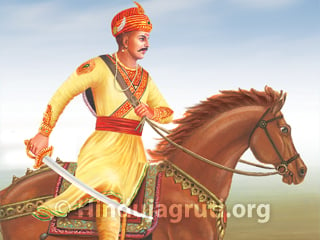
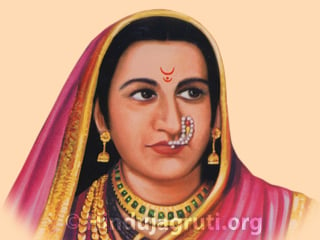 Rajmata Jijabai : Shivaji Maharaj's inspiration and Hindavi Swaraj visionary
Rajmata Jijabai : Shivaji Maharaj's inspiration and Hindavi Swaraj visionary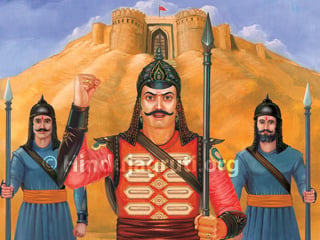 Maharana Pratap : Valour and indomitable spirit personified
Maharana Pratap : Valour and indomitable spirit personified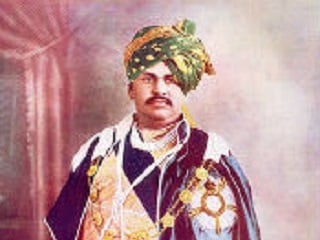 Chhatrapati Rajaram Maharaj
Chhatrapati Rajaram Maharaj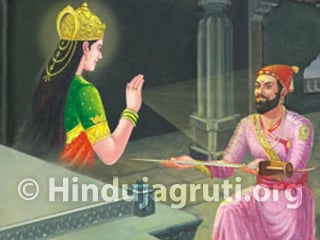 Chhatrapati Shivaji Maharaj
Chhatrapati Shivaji Maharaj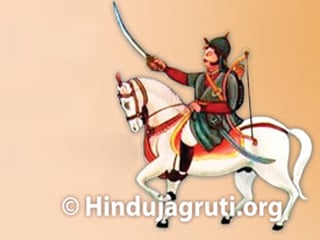 Great warrior King : Budelkhand Kesri Maharaja Chhatrasal
Great warrior King : Budelkhand Kesri Maharaja Chhatrasal Punyashlok Rajmata Ahilyadevi Holkar : Queen of the Kingdom of Malwa
Punyashlok Rajmata Ahilyadevi Holkar : Queen of the Kingdom of Malwa